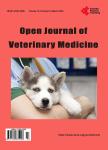Control of Canine Endoparasites,Especially Isospora spp.,with Procox^(■) in Naturally Infected Puppies:Parasitological,Bacteriological and Health Parameters
犬体内寄生虫,尤其是等孢球虫属的控制,与Procox在自然感染的小狗:寄生虫,细菌和健康参数作者机构:Institute of ParasitologyDepartment of PathobiologyUniversity of Veterinary Medicine ViennaViennaAustria Centre for Artificial Insemination and Embryo TransferDepartment for Small Animals and HorsesUniversity of Veterinary Medicine ViennaViennaAustria Functional MicrobiologyIBMHDepartment of PathobiologyUniversity of Veterinary Medicine ViennaViennaAustria Institute of VirologyDepartment of PathobiologyUniversity of Veterinary Medicine ViennaViennaAustria Institute of Animal NutritionDepartment for Farm Animals and Veterinary Public HealthUniversity of Veterinary Medicine ViennaViennaAustria Clinical Microbiology and Infection BiologyIBMHDepartment of PathobiologyUniversity of Veterinary Medicine ViennaViennaAustria Bayer Animal Health GmbHMonheimGermany
出 版 物:《Open Journal of Veterinary Medicine》 (兽医学(英文))
年 卷 期:2013年第3卷第2期
页 面:121-130页
学科分类:1002[医学-临床医学] 100201[医学-内科学(含:心血管病、血液病、呼吸系病、消化系病、内分泌与代谢病、肾病、风湿病、传染病)] 10[医学]
基 金:financially supported by Bayer Animal Health Germany
主 题:Dog Emodepside Gut Health Isospora Toltrazuril Toxocara Vaccination
摘 要:The effect of Procox? (Bayer, emodepside/toltrazuril suspension for dogs) against natural infections with Isospora spp. was investigated. Two groups were treated either with 0.5 ml suspension/kg of body weight (0.45 mg emodepside and 9 mg toltrazuril/kg of body weight) in the 3rd, 5th and 7th week of life (w.o.l.) (Procox? group;n = 28) or with a control anthelminthic (Dewormed Control group;n = 26). Animals were surveyed weekly from the 3rd w.o.l. by coproscopy and clinical examination. Faecal samples were examined microbiologically from the 4th to the 8th w.o.l. and faecal inflammatory markers canine calprotectin and canine S100A12 were measured in the 8th w.o.l. Specific antibody titres were evaluated in serum samples from five litters before and after vaccination against canine distemper virus and canine parvovirus 2. The prevalence of Isospora-positive animals increased to 67% in the Dewormed Control group (n = 15 puppies from four parasite-positive litters), while in the Procox? group (n = 15 puppies) it was less than 34% with significantly lower excretion (p ? was easily applied and effective;adverse effects did not occur. The level of seroconversion or titre increase upon vaccination was higher in parasite-free animals (91%) compared to Procox?-treated puppies (30%) and the Control animals (10%). Animals from parasite-free litters showed significantly different excretion patterns for haemolytic Escherichia coli and Clostridium perfringens, while there was no difference between Procox?-treated and Control animals. In some animals kept under poor hygienic conditions diarrhoea was noted in association with C. perfringens, E. coli or Salmonella. Concentrations of inflammatory markers in the faeces did not significantly differ between the Procox? and the Control group. Adequate control of parasitic and bacterial infections in suckling puppies requires both antiparasitic treatment and hygiene. Even when parasites do not cause overt effects treatment is recommended



